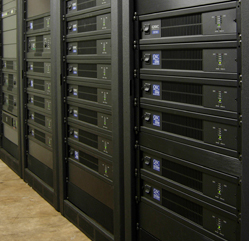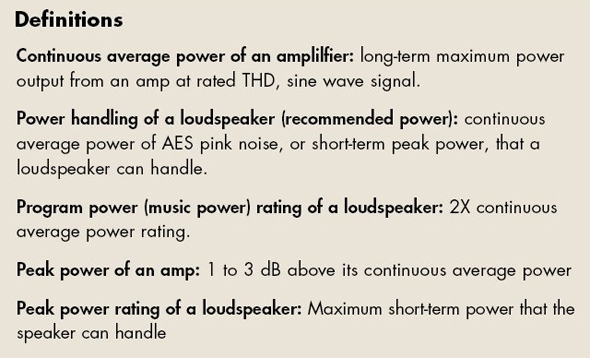
POWER VS. APPLICATION
This section will suggest how big a power amplifier you need to fill a venue with loud, clear sound.
Basically, the louder the sound system and the bigger the room, the more power is required.
Loudspeakers with high sensitivity need less power than loudspeakers with low sensitivity.
The list below recommends the amplifier power needed for several applications.
Each application has a range of power based on the desired loudness and the typical loudspeaker sensitivity.
In compiling this list, I made the following assumptions:
—Typical loudspeaker sensitivity is 85 dB SPL/W/m for home stereos, 95 dB SPL/W/m for small PA loudspeakers, 100-105 dB for medium PA loudspeakers, and 110 dB for large PA loudspeakers.
—The recommended power allows for signal peaks of 10 to 15 dB for folk, jazz and pop music. Actually the peaks might be as high as 25 dB, but we’re allowing for some inaudible short-term clipping.
—The recommended power allows for signal peaks of 6 dB for rock music that is highly limited or compressed.
—Amplifier continuous power and amplifier peak power are nearly the same. Typically, peak power is only 1 dB higher than continuous power, and depends on peak duration.
Continuous amplifier power per channel required in various applications:
—Nearfield monitoring: 25 watts for 85 dB SPL average (with 15 dB peaks), 250 watts for 95 dB SPL average (with 15 dB peaks)
—Home stereo: 150 watts for 85 dB SPL average (with 15 dB peaks), 1,500 watts for 95 dB SPL average (with 15 dB peaks)
—Folk music in a coffee shop with 50 seats: 25 to 250 watts
—Folk music in a medium-size auditorium, club or house of worship with 150 to 250 seats: 95 to 250 watts
—Folk music at a small outdoor festival (50 feet from loudspeaker to audience): 250 watts
—Pop or jazz music in a medium-size auditorium, club or house of worship with 150 to 250 seats: 250 to 750 watts
—Pop or jazz music in a 2000-seat concert hall: 400 to 1,200 watts
—Rock music in a medium-size auditorium, club or house of worship with 150 to 250 seats: At least 1,500 watts
—Rock music at a small outdoor festival (50 feet from loudspeaker to audience): At least 1,000 to 3,000 watts
—Rock or heavy metal music in a stadium, arena or amphitheater (100 to 300 feet from loudspeaker to audience): At least 4,000 to 15,000 watts
Although a rock concert in an arena could be powered by 15,000 watts (allowing only 6 dB of headroom for peaks,) you’ll often see large touring sound companies using 80,000 to 400,000 watts total. That much power is needed to handle 20-to-24 dB peaks without any clipping, and to power extra loudspeakers for even coverage of a large area.
If one loudspeaker won’t handle the total power required, you need to divide the total power among multiple loudspeakers and multiple amplifier channels.
For example, suppose you need 1,000 watts to achieve the desired average loudness, but your loudspeakers power handling is 250 watts continuous. You could use a power amplifier of 500 watts per channel. Connect two loudspeakers in parallel on each channel.
That way, each loudspeaker will receive 250 watts (not considering the change in amplifier power at different impedances, and not considering cable losses).
Note that if you parallel two loudspeakers, their total impedance is halved. For example, two 8-ohm loudspeakers in parallel have an impedance of 4 ohms. In that case, each loudspeaker would receive half of the amplifier’s 4-ohm power.

